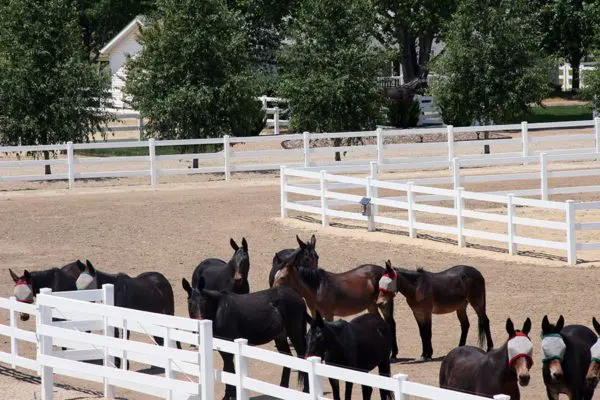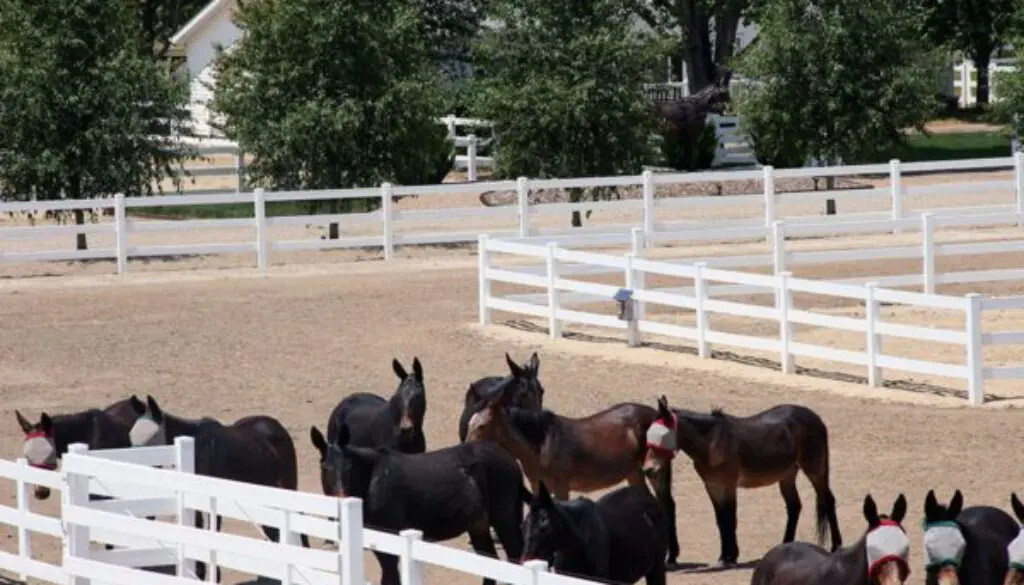MULE CROSSING: Owning an Equine Is Serious Business, Part 1
 By Meredith Hodges
By Meredith Hodges
While many of us were growing up, we were barraged with a deluge of ideas and attitudes about equines that were conveyed to us via multiple forms of media and educational sources. The role models of yesteryear were movies like, My Friend Flicka, books like The Black Stallion or Black Beauty, and TV shows like The Lone Ranger and Hopalong Cassidy. The most commonly known mules were “Francis,” who appeared in the Francis the Talking Mule series, and another mule known as “Ruth,” who appeared in the TV show, Gunsmoke. Those of us who tried to apply the management and training practices portrayed in the movies and books discovered that the things we saw on television and read in books covered only a fraction of what was really necessary, and the things that were shown and written about didn’t always work the same way in reality as they did in fiction.
Like many equine lovers, I was convinced that, when I got older, I would be able to have as many horses of my own as I wanted. I thought I would build a one hundred-stall barn and rescue all the abused horses in the country that I could. Surely, one hundred stalls could house almost all of them! Even into my early twenties, I believed this could happen. I honestly thought that all I needed was a patch of fenced grass and a shed out of the weather, and this simple solution would sufficiently provide for an equine. I was soon to discover the responsibility of health and finance that would burst my fantasy bubble and force me to deal with the hard realities of a life with equines. Once you confront these realities, you begin to really understand what is meant by “horse poor!” But more importantly, you discover how many important responsibilities there are when you own an equine.
Horses, mules and donkeys are living creatures with complex bodies that require not only proper nutrition and training but adequate space and the right kinds of fencing and housing. The standard rule of thumb is that you need two acres of land per equine, just for grazing. And, since equines cannot graze indefinitely without putting their bodies at risk for colic and founder, they also need space away from the lush green grass in the pastures. In addition, they cannot graze on just any kind of pasture. There are some grasses and plants that are toxic to equines and ingesting any of these potential hazards can result in sickness, paralysis or even death. It is important to familiarize yourself with the indigenous plants in your particular area that could be a potential hazard to your equine’s health and make sure they are removed from your property or, at the least, removed from the areas where your equine could gain access.
 There is no substitute for proper management. Ideally, all equines should be kept overnight and fed in a dry paddock or stall where their feed can be monitored. They should be gradually exposed to pasture in the springtime. Begin by turning them out for only an hour per day to start, and then work into more time, adding one hour to turnout time per week until their bodies are accustommed to the pasture intake. They can remain on pasture during the day as their weight will tolerate, but I have found that a maximum of five hours of pasture time per day is ideal. Anything over five hours tends to start adding unhealthy weight. This routine is easy to do if they are kept up overnight and fed morning and evening in either a separate area that is nothing but dirt, or in a stall and run. Multiple animals can be kept together overnight in a dry lot, provided that they are compatible by size, gender and type, and there is enough space to put out buckets for their crimped oats mix and grass hay—the buckets should be spaced at least 16 feet apart. Contrary to popular belief, alfalfa and other hot feeds are not really good for equines.
There is no substitute for proper management. Ideally, all equines should be kept overnight and fed in a dry paddock or stall where their feed can be monitored. They should be gradually exposed to pasture in the springtime. Begin by turning them out for only an hour per day to start, and then work into more time, adding one hour to turnout time per week until their bodies are accustommed to the pasture intake. They can remain on pasture during the day as their weight will tolerate, but I have found that a maximum of five hours of pasture time per day is ideal. Anything over five hours tends to start adding unhealthy weight. This routine is easy to do if they are kept up overnight and fed morning and evening in either a separate area that is nothing but dirt, or in a stall and run. Multiple animals can be kept together overnight in a dry lot, provided that they are compatible by size, gender and type, and there is enough space to put out buckets for their crimped oats mix and grass hay—the buckets should be spaced at least 16 feet apart. Contrary to popular belief, alfalfa and other hot feeds are not really good for equines.

Before the industrial age and the onset of urban sprawl, equines were more independent, and many roamed free on the open range. Horses were kept in bands, or remudas, and rounded up when it was necessary to use them for ranch work and herding cattle. Most often, the abuse of horses in literature was portrayed, as in Black Beauty, on the busy streets of the cities, where they were overloaded or overworked in harness. Abusive training practices that were done in the more rural areas were deemed necessary and normal for the breaking of horses and mules. These equines were considered “wild” and hard to tame. Few people ever thought that perhaps the resistance they encountered from the equine was due to the approach and handling by the trainer. Because the donkey is a more placid animal, he was deemed stubborn and, thus, more harmless than his equine counterparts, so he subsequently became the mount of choice for ladies and young beginning riders. The harsh breaking of horses and mules was accepted in this country as a necessary evil when in reality, it was really only a contest of strength among men, and a peculiarity of the New World. The art of Classical Horsemanship and a more humane method of training equines had been present in Europe for nearly a hundred years prior to the time of the American cowboys.

Throughout history, classically trained horsemen and women were aware of the value in the careful upbringing of the horse (or mule) as a useful and economically valuable animal that was beneficial to their civilization (particularly in the art of warfare). Horses were brought up in as close to the conditions of the wild as possible, but, with the encroachment of urbanization, the space to run free became less and less available. Classical Horsemanship is still practiced today and allows young horses to grow slowly, while formal training is kept to a healthy minimum. Young equines are ridden only after they have done plenty of body building groundwork and have reached the age of four. Today, equines must live in a completely different environment than they once knew, so we all need to understand that what we read about in books and see in movies and on television is no more than entertainment, and not an accurate portrayal of the reality of owning an equine.
Equines have unjustly become a commodity of our capitalistic system—they are treated more like a product to be bought and sold and less like the living and breathing creatures that they are. People buy and sell equines like cars, expecting them to be “tuned up” and stay that way for unskilled owners. Unsuspecting owners are often sold a “bill of goods” by practiced salespeople—animals and the responsibilities associated with them can easily be misrepresented to an unskilled buyer and, quite often, equines do not meet the unrealistic expectations of an inexperienced equine lover. Unless a buyer has family or a friend in the horse business, there is no reason they should know all the responsibilities that come with being an equine owner. But even if you do not have equine experience, if you plan to own an equine, you still have a responsibility to educate yourself as thoroughly as possible, so that you can give your equine partner the best care possible.
Remember: Be prepared to develop a lifestyle with your new equine that includes reliable routine, regular visits from your selected equine professionals and positive interaction with your equine on a daily basis.
The responsibility of maintaining an equine may seem overwhelming at first, when all you wanted to do was get a horse, pony, mule or donkey to ride or drive. But if you are a willing student and consistent in your own behavior, it soon becomes a pleasure to care for such a deserving partner in life. In Part 2 of this article, you will get a comprehensive list of best practices for the care and management of your new equine.
To learn more about Meredith Hodges and her comprehensive all-breed equine training program, visit LuckyThreeRanch.com, MEREDITH HODGES PUBLIC FIGURE Facebook page, or call 1-800-816-7566. Check out her children’s website at JasperTheMule.com. Also, find Meredith on Pinterest, Instagram, MeWe, YouTube and Twitter.
Covered in TRAINING MULES & DONKEY: A LOGICAL APPROACH TO TRAINING, TRAINING WITHOUT RESISTANCE, EQUUS REVISITED and A GUIDE TO RAISING & SHOWING MULES at www.luckythreeranchstore.com.
© 2012, 2016, 2018, 2024 Lucky Three Ranch, Inc. All Rights Reserved.





Chuck Bartok
May 1, 2018 @ 3:45 pm
Wonderful article and well written.
One observation after 50 years hanging out with equines is they provide an excellent classroom for young people to learn how to accept responsibility, develop solid relationships and learn to give and take.
It is so rewarding to meet many of the “kids” who hung out at our place and realize what fine adults, parents, and contributors to a healthy society they grew into.
All of them give gratitude to the Equine for beinf=g so instrumental in allowing them to mature with Chararcter